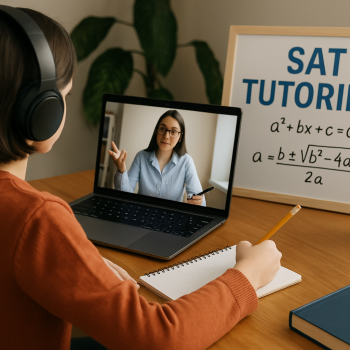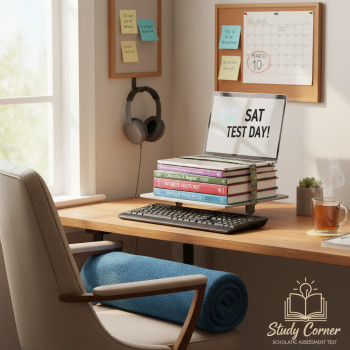Why flashcards are still one of the best tools for SAT prep
Flashcards feel simple, maybe even old school. But that simplicity is their power. In a test like the SAT, where you need quick recall of vocabulary, grammar rules, math formulas, and data-interpretation techniques, flashcards give you a low-friction, high-return way to practice. They force you to actively retrieve information, and active retrieval is one of the strongest ways to make knowledge stick.
This article is a friendly, practical guide to using flashcards the right way for SAT prep. Whether you prefer paper cards or digital decks, we cover how to write effective cards, how to schedule reviews, how to mix content types, and how to use flashcards alongside other study methods. I also weave in how Sparkl’s personalized tutoring can fit into your flashcard strategy, offering 1-on-1 guidance, tailored study plans, expert tutors, and AI-driven insights to make your practice smarter.
Active recall vs passive review: the heart of the flashcard advantage
There are two ways to “study” with a flashcard: you can glance at cards and nod along, or you can test yourself. That second approach is active recall, and it matters. When you try to retrieve an answer from memory, your brain strengthens the neural pathway associated with that information.
- Passive review: flipping a card and reading the answer again. Comfortable, but weak retention.
- Active recall: attempting to answer before flipping. Harder, but the retention payoff is far higher.
Make every flashcard session a testing session. Silence distractions, look at the prompt, and force yourself to produce the answer. If you can, say the answer out loud or write it down before you flip the card.
Designing powerful SAT flashcards
Good flashcards are short, focused, and purposeful. The SAT tests several domains, and each type needs a slightly different card design.
Vocabulary cards
- Front: the word alone. Example: prudent.
- Back: a concise definition, a short synonyms list, and one original sentence that shows how the word is used in context. Example: “wise and careful; sensible. Synonym: cautious. She made a prudent choice to save money for college.”
Try to use your own sentence rather than one copied from a list. Personal associations are more memorable.
Grammar and writing cards
- Front: a short sentence with an error highlighted, or the rule name. Example front: “Each of the students ___ planning to travel.”
- Back: corrected sentence plus a one-line rule. Example back: “is; ‘each’ is singular and takes a singular verb.”
Math cards
- Front: a short problem or a formula prompt. Example: “Distance formula between (x1,y1) and (x2,y2).”
- Back: the formula and a one-line explanation or small worked example. For problem cards, show the solution steps but keep them concise.
Data analysis and interpretation cards
- Front: a data snippet or a short chart description and the question. Example: “If 40% of company A are interns, and total staff is 250, how many interns?”
- Back: calculation and quick tip for similar questions. Example: “100 interns; multiply 0.4 * 250. When percent questions appear, translate to decimals immediately.”
Quality rules for every flashcard
- Keep it brief. One idea per card.
- Use your own words; personalization helps retention.
- Include cues that force you to think — avoid giving away the answer in the question.
- If a card requires multi-step reasoning, break it into two or more cards so each card tests a single skill.
- For vocabulary, prefer example sentences over definitions when possible.
Spaced repetition: timing your reviews for maximum memory
Spaced repetition is the practice of reviewing material at increasing intervals so you study information just before you’re likely to forget it. It leverages the forgetting curve — review at the right times and you cement knowledge with much less overall time than passive cramming.
Here is a sample schedule using a simple spaced repetition approach you can apply manually or replicate in a digital system:
| Review Stage | When to Review | Purpose |
|---|---|---|
| Stage 1 | Same day | Initial encoding; confirm you understand the card |
| Stage 2 | 1-2 days later | Short-term consolidation |
| Stage 3 | 5-7 days later | Shift to longer-term memory |
| Stage 4 | 2-3 weeks later | Deep retention |
| Stage 5 | 2-3 months later | Maintenance |
If you forget a card at any stage, return it to an earlier stage until you can answer it reliably. The Leitner system is a practical way to operate this schedule with paper flashcards: move known cards to less-frequent boxes and unknown cards to more-frequent boxes.
Paper vs digital flashcards: pick what fits your learning
Both paper and digital flashcards have distinct benefits. The right choice depends on how you study and what you want to track.
- Paper cards: tactile, portable, and distraction-free. Great if you retain information better by writing and creating your own cards.
- Digital cards: automatic spaced repetition scheduling, searchable, and often support images and audio. They can also show statistics so you know which cards are weak.
Many students use a hybrid approach: write key cards by hand to build memory, then transfer them to a digital deck for automated review and tracking. If you work with a tutor, like one from Sparkl’s personalized tutoring service, your tutor can help decide which combination fits your habits and goals.
Mix content types and practice retrieval under test-like conditions
The SAT requires you to switch quickly between content types. To prepare for that, interleave your flashcards rather than reviewing one type at a time. Put vocabulary, grammar, math, and data-analysis cards in the same session so your brain practices switching contexts.
Also, simulate test conditions periodically. Use timed review sessions, force yourself to write answers for math cards without a calculator if you’re practicing no-calculator sections, and practice reading comprehension vocabulary in the context of short paragraphs rather than isolated words.
Examples: what great SAT flashcards look like
Here are a few sample cards you could write today.
- Vocabulary card
- Front: ubiquitous
- Back: “found everywhere; omnipresent. Synonym: pervasive. Example: Smartphones have become ubiquitous on college campuses.”
- Grammar card
- Front: “Neither of the answers ___ correct.”
- Back: “is; ‘neither’ is singular and takes a singular verb.”
- Math formula card
- Front: “Area of a triangle”
- Back: “1/2 * base * height. Use when you know perpendicular height; if you only have coordinates, use coordinate geometry methods.”
- Problem card
- Front: “If 5x + 3 = 18, what is x?”
- Back: “x = 3; subtract 3 then divide by 5.”
How to avoid common flashcard mistakes
- Too much information on a card. If you need more than a sentence, split the card.
- Creating cards passively. Writing a card and never testing it is wasted effort. Turn creation time into immediate practice by testing right after you make a card.
- Studying cards on autopilot. Keep the sessions short and focused. Quality beats quantity.
- Ignoring application. Vocabulary tested only in isolation may not transfer well to passages. Practice using words in sentences and passages.
Integrating flashcards into a study plan
Consistency is more important than marathon sessions. Here is a practical weekly layout that balances flashcards with other SAT activities like practice tests and targeted tutoring.
| Day | Focus | Flashcard Role |
|---|---|---|
| Monday | Vocabulary + grammar | 30 minutes mixed flashcards; add 10 new vocabulary cards |
| Tuesday | Math concepts | 30 minutes problem and formula cards; create 5 new problem cards |
| Wednesday | Practice section | Flashcard warm-up 20 minutes; review mistakes from practice |
| Thursday | Data and graphs | 25 minutes flashcards on interpretation tips and formulas |
| Friday | Mixed review | 40 minutes interleaved flashcards; focus on weak cards |
| Saturday | Timed practice test | Quick flashcard review before test; post-test update of cards |
| Sunday | Rest and light review | 15 minutes flashcards for maintenance |
Remember: the overall study plan should fit your available time and stamina. If you only have 30 minutes a day, make those minutes count with focused flashcard practice and one longer weekly practice test.
Using flashcards with a tutor and AI-driven feedback
Flashcards are a personal tool, but you don’t have to build them alone. A tutor can help you identify which concepts deserve cards, craft high-quality prompts, and spot patterns in mistakes that your flashcards should address. Sparkl’s personalized tutoring brings 1-on-1 guidance and tailored study plans that mesh well with flashcard practice: your tutor can suggest which cards to prioritize and how to refine them. When combined with AI-driven insights, you can see which cards are weak across sessions and get suggestions for better phrasing or for breaking a card into smaller parts.
Tracking progress: metrics that matter
Don’t measure success by the number of cards you create. Measure by recall rates and application. Useful metrics include:
- Proportion of correct responses per session.
- Cards moved to long-term boxes or marked as mastered.
- Time to recall an answer — if it becomes faster, that’s progress.
- Reduction in similar mistakes on full practice tests.
Digital tools can show these metrics automatically, while paper systems need occasional manual tracking. Use metrics to refine study plans and to tell your tutor where to focus one-on-one sessions.
Advanced techniques to supercharge flashcards
- Elaborative interrogation: when you answer a card, ask yourself why the answer is true and say that explanation aloud.
- Dual coding: add a simple sketch or mental image to a card. Visual cues help especially with data interpretation and geometry.
- Interleaving: mix card types and difficulty levels in each session to build flexible problem-solving skills.
- Self-explanation: after solving a math card, explain the steps to an imagined peer. Teaching is powerful.
Real-world examples: how students use flashcards successfully
One student I worked with used flashcards to improve in the Writing and Language section. She created cards for specific punctuation rules and then wrote three example sentences for each card. After four weeks of daily active recall, she reduced grammar-related mistakes by half on practice sections. Another student used problem flashcards for algebraic manipulation and moved tough cards back to daily review until they felt automatic. Both combined their card practice with weekly tutoring sessions to correct bad habits early.

When flashcards are not enough
Flashcards are powerful for memorization and quick recall, but the SAT also requires comprehension, reasoning, and test strategy. Flashcards should be one part of a balanced plan that includes full-length practice tests, passage-based reading practice, math problem solving under timed conditions, and strategy sessions for pacing and question triage.
If you struggle to apply what your cards teach under test pressure, bring those weaknesses into your flashcard deck. Make cards that simulate application, not just definitions. Work with a tutor to create higher-order cards that require steps or short written responses.
Final checklist: make flashcards work for you
- Write one idea per card and keep the prompt focused.
- Always use active recall before revealing the answer.
- Space your reviews and return forgotten cards to more frequent cycles.
- Interleave content types and practice under timed conditions.
- Track recall rates and adjust focus to weak areas.
- Use tutors and AI insights where possible to refine cards and prioritize study time.
Parting thought: small cards, big gains
Flashcards are deceptively simple. When designed and used thoughtfully, they turn short, repeated practice into lasting knowledge — exactly what the SAT rewards. Start small, test often, and refine your cards based on real mistakes. If you use flashcards in combination with targeted tutoring, like Sparkl’s personalized approach that offers 1-on-1 guidance, tailored study plans, expert tutors, and AI-driven insights, you can speed up progress and spend time only on what truly improves your score.
So grab a stack of cards or open a new digital deck, write a few smart cards today, and make active recall your daily habit. You might be surprised how quickly small, consistent efforts add up to a major score improvement.













No Comments
Leave a comment Cancel